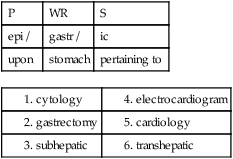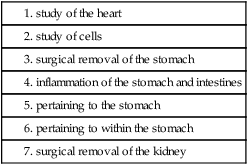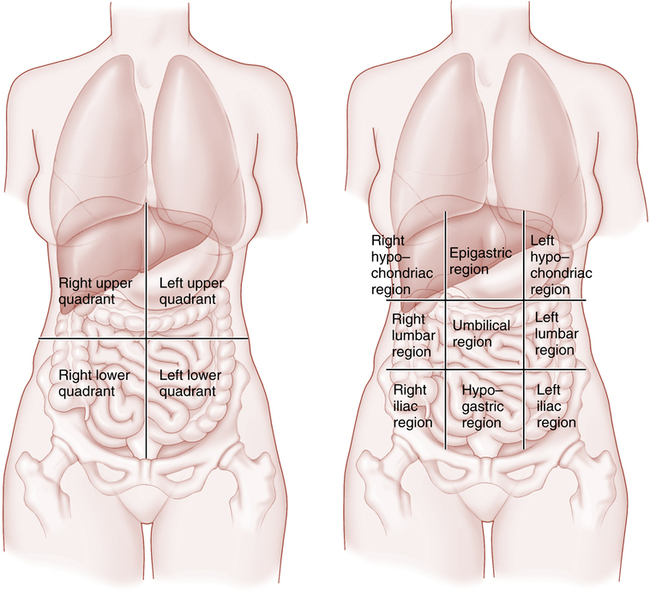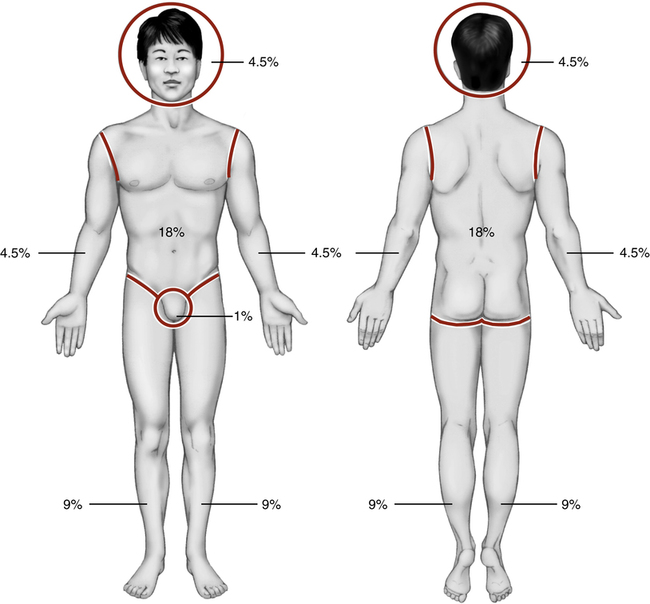Chapter 22
Medical Terminology, Basic Human Structure, Diseases, and Disorders
Unit Objectives
On completion of this unit, you will be able to:
1. Identify the three main origins of medical terms.
2. Name and define the four word parts that are commonly used in building medical terms.
3. List three guidelines to follow when connecting word parts to form a medical term.
4. Define analysis of medical terms.
5. Given a list of medical terms and a list of word parts, divide the medical terms into their component parts—that is, word roots, prefixes, suffixes, and combining vowels—and identify the types of word parts present in each term by name.
6. Define synthesis of medical terms.
7. Given a description of a medical term and a list of word parts—that is, word roots, prefixes, suffixes, and combining vowels—write out the medical term that represents a stated medical condition.
Word Parts
Combining Vowel
1. When a word root is connected to a suffix, a combining vowel usually is not used if the suffix begins with a vowel. For example, in the word [gastr / ectomy], ectomy (surgical removal) begins with the vowel e; thus the combining vowel o is not used.
2. When two word roots are connected, the combining vowel is usually used even if the second root begins with a vowel. For example, in the word [gastr / o / enter / itis], the second word root enter (intestine) begins with the vowel e, but the combining vowel o is still used.
3. A combining vowel is not used when a prefix and a word root are connected. For example, in the medical term [sub / hepat / ic], a combining vowel is not used between the prefix, sub-, and the word root, hepat.
| Word Root | Meaning |
| cardi / o | heart |
| cyt / o | cell |
| electr / o | electricity, electrical activity |
| enter / o | intestine |
| gastr / o | stomach |
| hepat / o | liver |
| nephr / o | kidney |
| Prefixes | Meaning |
| intra- | within |
| epi- | upon |
| sub- | under, below |
| trans- | through, across, beyond |
| Suffixes | Meaning |
| -ectomy | excision, surgical removal |
| -gram | record, x-ray image |
| -ic | pertaining to |
| -itis | inflammation |
| -logy | study of |
Unit Objectives
On completion of this unit, you will be able to:
1. Describe the function and structure of body cells.
2. Identify and describe the function of four types of tissue
3. Explain the structure of an organ and the structure of a system.
4. List five body cavities, and name a body organ contained in each cavity.
5. List the four quadrants and nine regions of the abdominopelvic cavity.
6. Define the anatomical position and the directional terms outlined in this unit.
7. List four functions of skin.
8. List the seven signs of cancer, and describe first-, second-, and third-degree burns.
9. Define abscess, laceration, abrasion, gangrene, infection, and decubitus ulcer.
10. Read the objectives related to medical terminology, and demonstrate ability to meet the objectives by completing Exercises 1 through 6.
Body Structure (Anatomy) and Function (Physiology)
Body Cells
The cell is the basic unit of all living things (Fig. 22-1). The human body is made up of trillions of cells. Cells perform specific functions, and their size and shape vary according to function. Bones, muscles, skin, and blood are all made up of different types of cells. Body cells are microscopic; approximately 2000 are needed to make an inch (although a single nerve cell may be several feet long). Cells are constantly growing and reproducing. Such growth is responsible for the development of an embryo into a child and a child into an adult. This growth is also responsible for the replacement of cells that have a relatively short life span and cells that are injured, diseased, or worn out.
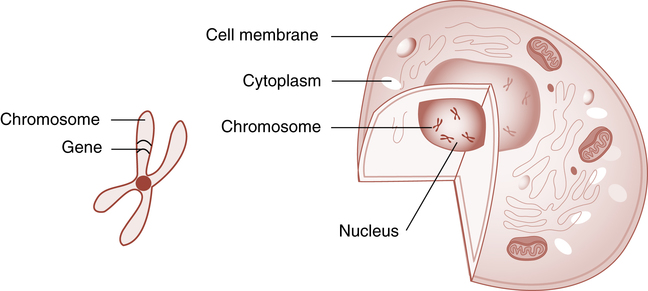
Body Tissues
A tissue is made up of a group of similar cells that work together to perform particular functions (Fig. 22-2). Tissues may be categorized into the following types:
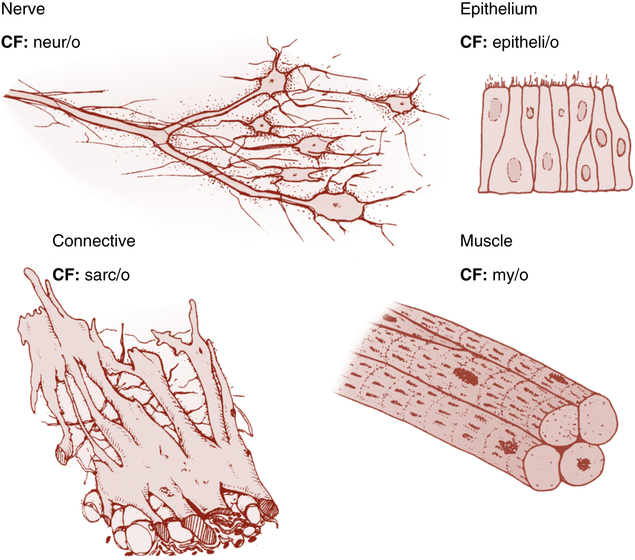
• Epithelial tissue: Epithelial tissue forms a protective covering (skin) or lines body cavities (e.g., digestive, respiratory, and urinary tracts).
• Connective tissue: The main functions of connective tissue are to connect and hold tissues together, to transport substances, and to protect against foreign invaders. Connective tissue forms and protects bones, fat, blood cells, and cartilage and provides immunity.
• Muscle tissue: Muscle tissue makes up the muscles of the body that contract and relax to produce movement.
• Nerve tissue: Nerve tissue forms parts of the nervous system; it conducts electrochemical impulses and helps to coordinate body activities.
Body Systems
A body system is made up of a group of organs that work closely together in a common purpose to perform complex body functions (Fig. 22-3). For example, the urinary system is made up of the following organs: kidneys, ureters, urinary bladder, and urethra. Its main function is to remove wastes from the blood and eliminate them from the body. Other body systems include the digestive, musculoskeletal, nervous, reproductive, endocrine, circulatory, respiratory, sensory, and integumentary systems. Some organs are a part of more than one system. The pharynx, for example, is part of both the digestive and the respiratory systems. In the digestive system the pharynx allows for the passage of food; in the respiratory system it allows for the passage of air.
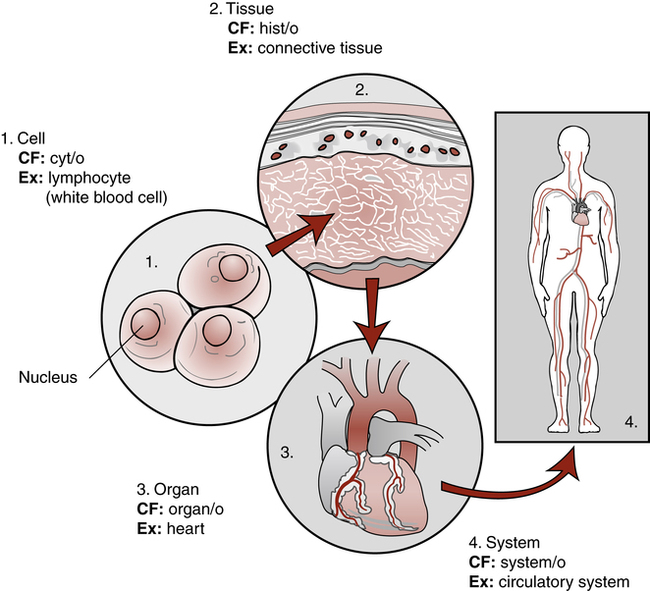
Body Cavities
Large spaces within the body that contain internal organs, or viscera, are called body cavities (Fig. 22-4). The two major body cavities are the dorsal cavity (near the back) and the ventral cavity (near the front).

Ventral Cavity
The ventral cavity is composed of the thoracic (or chest) cavity and the abdominopelvic cavity.
• Thoracic cavity: The chest cavity contains additional spaces, including right and left pleural cavities and the mediastinum. Organs within the thoracic cavity include the heart, lungs, trachea, esophagus, thymus gland, and major blood vessels.
• Right and left pleural cavities: Double-walled sacs that create spaces that surround the lungs.
• Mediastinum: Space that contains the heart, trachea, esophagus, thymus gland, and major blood vessels.
• Abdominopelvic cavity: This space is divided into the abdominal cavity and the pelvic cavity.
• Abdominal cavity: Upper portion of the abdominopelvic cavity. This space contains the stomach; most of the intestines; and the kidneys, ureters, liver, pancreas, gallbladder, and spleen. The abdominal cavity is separated from the thoracic cavity by a muscle called the diaphragm.
• Pelvic cavity: Lower portion of the abdominopelvic cavity. This space contains the bladder, urethra, reproductive organs, part of the large intestine (sigmoid colon), and the rectum. The abdominopelvic cavity is divided into four quadrants and nine regions (Fig. 22-5). You will frequently encounter these descriptive terms during your health care employment.
Directional Terms Pertaining to the Body
Directional terms, which are used to describe a location on or within the body, refer to the patient in the anatomical position. Anatomical position is the point of reference that ensures proper description: body erect, face and feet forward, arms at side, and palms facing forward. In Figure 22-11 (in Unit 3 of this chapter), the skeletal orientation is in the anatomical position.
• Superior (cranial): Pertaining to above. (The eye is located superior to the mouth.)
• Inferior (caudal): Pertaining to below. (The mouth is located inferior to the nose.)
• Anterior (ventral): Pertaining to in front of. (The eyes are located on the anterior of the head.)
• Anteroposterior (AP): Pertaining to front to back. (Directionally moving from the front to the back.)
• Posterior (dorsal): Pertaining to in back of. (The gluteus maximus is posterior to the navel.)
• Posteroanterior (PA): Pertaining to back to front. (Directionally moving from the back to the front.)
• Lateral (lat): Pertaining to the side. (The little toe is lateral to the big toe.)
• Bilateral (bilat): Pertaining to two (both) sides. (Bilateral otitis media [ear infections].)
• Medial: Pertaining to the middle. (The nose is medial to the ears.)
• Abduction: Pertaining to away from. (Spreading the fingers wide apart is an example of abduction.)
• Adduction: Pertaining to toward. (Bringing the fingers together from being spread out shows adduction.)
• Proximal: Pertaining to closer than another structure to the point of attachment. (The elbow is proximal to the wrist.)
• Distal: Pertaining to farther than another structure from the point of attachment. (The fingers are distal to the elbow.)
• Superficial: Toward the surface. (Hair follicles are superficial structures.)
• Deep: Farther from the surface. (The femur is deep to the skin.)
• Prone: Lying with the face downward. (The patient is placed in a prone position for suturing of the back of her head.)
• Supine: Lying on the back. (Supine positioning was required for his sternal puncture.)
Integumentary System
The integumentary system consists of the skin (the largest organ of the body) and accessory structures (hair, nails, and sweat and oil glands) (Fig. 22-6). The skin of an adult may weigh 20 pounds or more. The skin has many functions. The main one is to protect underlying tissues from pathogenic (disease-causing) microorganisms and other environmental hazards. The skin also assists in the regulation of body temperature and the synthesis of vitamin D. As a sensory organ, the specialized receptors of the skin pass messages of pain, temperature, pressure, and touch to the brain.
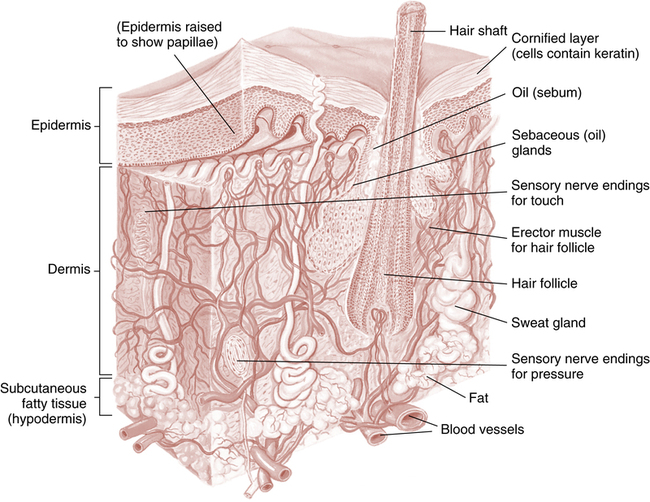
Diseases and Conditions of the Skin and Body Cells
Cancer
Burns
All burns are dangerous if they are not treated properly, because infection can occur and because shock is possible in more serious burns as a result of fluid loss from the skin. Burns are classified according to degree of severity, which reflects the depth of the burn (full or partial thickness) (Fig. 22-7) and the extent of surface area involvement (Fig. 22-8).
1. First-degree burns damage the epidermis. Also called a partial-thickness burn, sunburn is an example of a first-degree burn in which redness, minor discomfort, and slight edema may be present.
2. Second-degree burns damage the epidermis and the dermis. Also called partial-thickness burns, second-degree burns account for symptoms such as redness, pain, edema, and blisters.
3. Third-degree burns destroy the epidermis, dermis, and subcutaneous tissue. They are also called full-thickness burns. No pain occurs because the skin’s sensory receptors are destroyed. Third-degree burns heal only from the edges, and débridement (removal of dead skin) and skin grafts are necessary.
Infection
Infection is the invasion of the body by pathogenic microorganisms that reproduce and multiply, causing disease. Infections may be caused by streptococcal, staphylococcal, or Pseudomonas bacteria; by viruses; or by other organisms. Bacterial infections are treated with antibiotic therapy. Methicillin-resistant Staphylococcus aureus (MRSA) is one of several nosocomial (hospital- or health care setting–acquired) pathogens (see Chapter 14). Often the main mode of transmission of nosocomial infections in the clinical setting is through the hands of health care workers. These pathogens can be found on the skin, in the nose, and in blood and urine. Proper hand cleansing techniques should be reviewed with new employees by the infection control department of the clinical setting to avoid transmission of MRSA.
 Review Questions
Review Questions
1. Describe the function and structure of body cells.
2. Identify and describe the function of four types of tissue.
3. Explain the structure of an organ and the structure of a system
4. List five body cavities and name a body organ contained in each cavity
5. List the four quadrants and nine regions of the abdominopelvic cavity.
6. Define the anatomical position.
7. Match each directional term in Column 1 with its correct meaning in Column 2.
| Column 1 | Column 2 |
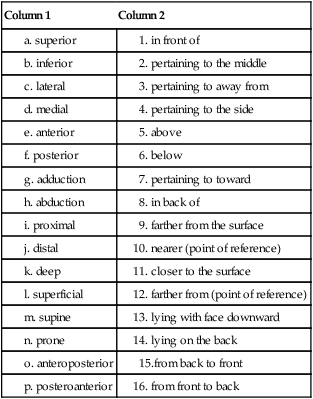
8. List four functions of the skin.
9. What is the thin outermost layer of the skin called? What is the thick layer of skin directly below this layer called? What is the innermost layer of fat-containing tissue called?
10. Skin color is determined by the amount of ______________ in the skin. Absence of this results in _________________.
11. Name the glands that produce oil that lubricates the skin and hair.
12. ___________________ open to the surface of the skin in tiny openings called pores.
13. List the seven signs of cancer and describe first-, second-, and third-degree burns.
14. Match the terms in Column 1 with the phrases in Column 2.
| Column 1 | Column 2 |
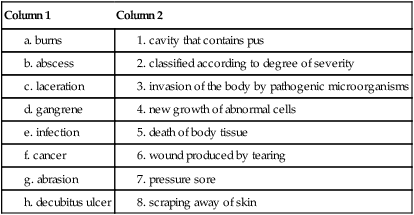
Medical Terminology Related to Body Structure, Integumentary System, and Oncology
On mastery of medical terminology for this unit, you will be able to:
1. Define, spell, and pronounce the medical terms listed in this unit.
2. Analyze the medical terms that are built from word parts.
3. Given the meaning of a medical condition, build the corresponding medical terms, using word parts.
Word Parts
| Word Roots/Combining Forms | Meaning |
| bi / o (bī′-yo) | life |
| cancer / o, carcin / o (kăn-sĕr-ō) (kar′-sĭn-ō), | cancer |
| cutane/ o (kyū-tā′-nē-ō), | skin |
| cyt / o (sī′-to) | cell |
| dermat / o (dĕr′-mě-tō) | skin |
| derm / o (dĕr′-mō) | skin |
| epitheli / o (ĕp-ī-thē′-lē-ō) | epithelium |
| hist /o (hĭs′-to) | tissue |
| lip / o (lĭp′-ō) | fat |
| onc / o (ŏn′-kō) | tumor |
| path / o (păth′-ō) | disease |
| sarc / o (sar′-cō) | connective tissue, flesh |
| trich / o (trĭk′-ō) | hair |
| ungu / o (ŭng′-ŭ-ō) | nail |
| viscer / o (vĭs′-ĕr-ō) | internal organs |
| Prefixes | Meaning |
| sub- | under, below |
| trans- (trăns) | through, across, beyond |
| Suffixes | Meaning |
| -al, -ous | pertaining to |
| -genic (jĕn′-ĭk) | producing, originating, causing |
| -itis (ī′-tĭs) | inflammation |
| -oid (oyd) | resembling |
| -logist (lŏ′-jĭst) | one who specializes in the diagnosis and treatment of (doctor) |
| -logy (lŏ′ -jē) | study of |
| -oma (ō′-mah) | tumor |
| -opsy (ŏp′-sē) | to view |


